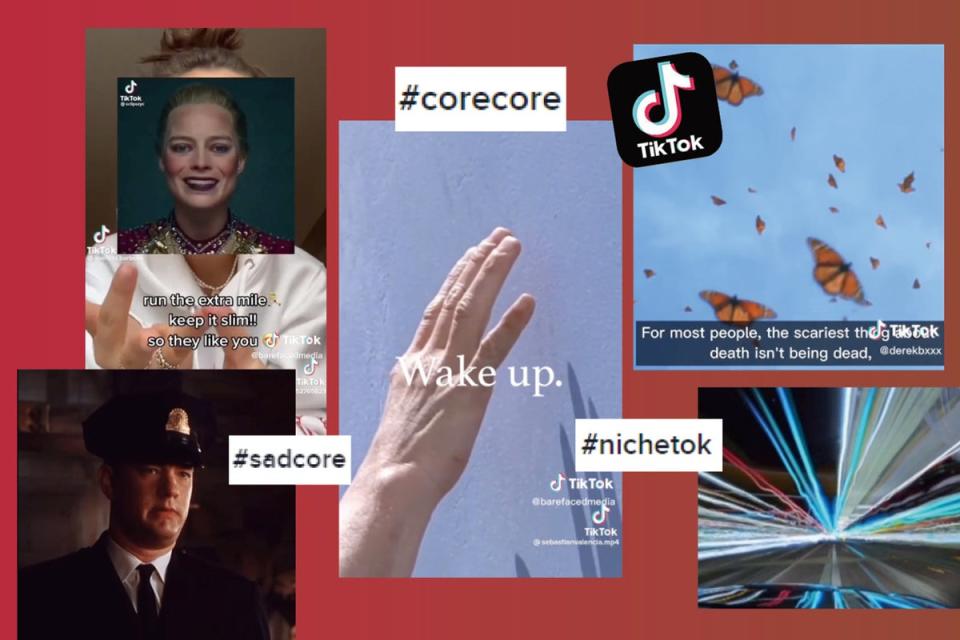‘Corecore’: TikTok’s new anti-trend aesthetic movement

Even if you’ve never downloaded TikTok, you’ve probably still heard of a “-core”. Used as a modifier to describe a type of aesthetic — for example, cosy nature lovers have been rebranded as devotees of “Cottagecore”, while fans of a maximalist lifestyle are lovingly embracing “Cluttercore,” apparently.
However, over the last few years “-core” microtrends have become prolific, to the point of exhaustion. Every day it feels like a niche, nonsensical one drops (coastal Grandmacore, anyone?), with the term now symbolic of our always-on, endless scrolling culture.
Enter: “corecore” which, according to Know Your Meme website, is an “anti-trend” that “plays on the -core suffix by making a “core” out of the collective consciousness of all ‘cores.’”
Even more confused? You’re not alone. In non-chronically online speak, “corecore” is a new aesthetic style of video that amateurishly edits together short clips mined from social media, YouTube, film scenes and news segments alongside emotionally rousing music. For example, in one popular corecore video, a clip from an interview where a kid is asked how much he wants to make as a doctor (he responds: “I’m gonna make people feel OK.”) is stitched next to a man talking about chicken “living in the metaverse”. In another, there’s the scene of Ryan Gosling screaming in the film Blade Runner 2049 next to sped-up videos of people walking in an overpopulated city. Commenting on the post-2020 condition, whether that be our culture’s obsession with overconsumption, the chronic loneliness epidemic or rising climate change anxiety, all share the ability to evoke emotion in the watcher — both good and bad.
So far, they’ve been likened to filmmaker Adam Curtis’ use of archival footage in documentaries such as Hypernormalisaton, and have been affectionately nicknamed “meme-poetry”. According to one TikTok user, corecore is: “life changing because it makes you see the visual of your sad and meaningless life.” Another said corecore “shows the human experience in a way that can’t be put into words.”
The format’s roots date back to 2020, when it was originally referenced as an aesthetic on Tumblr before infecting TikTok. Known first as #NicheTok, the hashtag was first used in July 2022. Since then, it’s had 1.3 billion views (with #Corecore having 2.1 billion).
John Rising, 40, known on TikTok as @HighEnquiries, is credited as one of the genre’s first creators. “I’ve never really felt a need to give it a name, I was just trying to make videos that evoked some sort of reaction in people,” he told Vice earlier this year.
“The subject can be anything I want to talk about, like the cost of living crisis, but some of them are a bit vague — you could say they’re about the general human condition.”
Fans have quickly started calling corecore a new art movement, with TikToker @Aamir pointing out in a January 14 video that corecore could sit alongside the 20th-century movement Dada, whose artists wielded collage, cut up text, sculpture, and multimedia to troll bourgeoisie aesthetics.
Aamir references Duchamp’s 1917 readymade Fountain, which consisted of a porcelain urinal signed “R.Mutt”. He said TikTok’s corecore genre was also elevating the meaninglessness of an everyday experience — in this case, the oversaturation of content — by “the sole act of representing it”.
“What does art do,” he continues in the TikTok which has now been watched 900,000 times, “if not attach meaning to the meaningless and arbitrary experiences we have as humans.”
However, some have questioned how radical they truly are, considering they are made from and for the same platforms they critique. “The videos we make are excruciatingly ironic because the means in which we make them is sourcing, compiling and recycling content from a platform we hate, and publishing it back to that same platform to receive our own commodity in the form of likes and engagement,” corecore content creator Eddie Hewer, 19, told i-D magazine. “We scream from within a chamber in which we can only hear the others screaming.”
Whether or not it’s a passing fad, corecore’s, um core (sorry), message is here to stay. As concern for “addictive algorithms” came up repeatedly during the US’s congressional hearing over potential TikTok’s ban and with data from Qustodio showing that children globally spend an average of 75 minutes per day on the app, maybe it’s time to log off — or, at the very least, reassess our social media consumption.

 Yahoo Sport
Yahoo Sport 





































